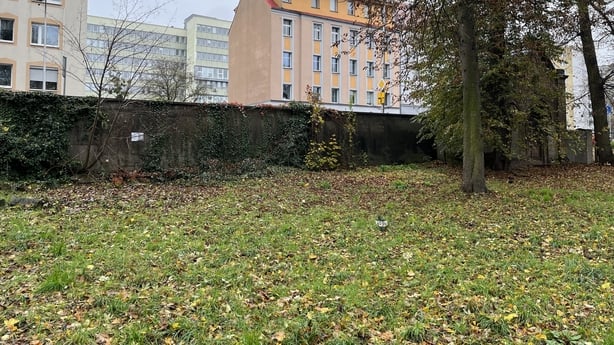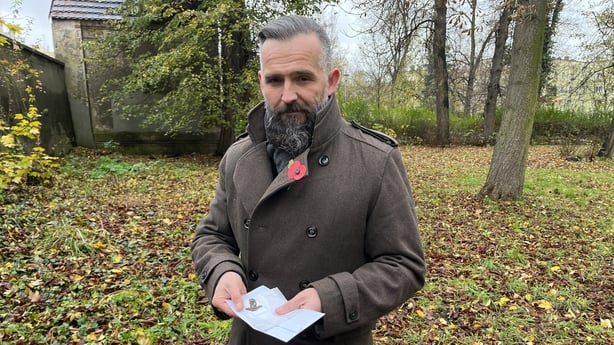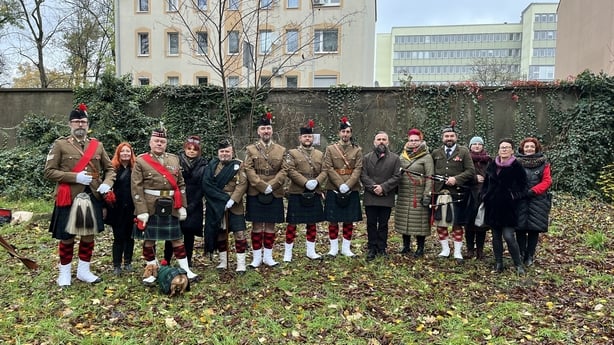Last Saturday, rain drizzled over a disused cemetery in Opole, a city in southern Poland.
A dozen or so local history enthusiasts had gathered to pay their respects to Irish and British soldiers who had died during a forgotten peacekeeping mission a century ago.
Half of the attendees were part of a World War I reenactment group and wore kilts, and two members of their clan played the bagpipes.
Passers by would hardly notice that a plot in a corner of the cemetery is the final resting place of 30 British army soldiers, their graves left unmarked for most of the past century.
Eleven of the dead soldiers were Irish.
There are no headstones, just a small laminated plaque on a wall listing the names of the dead.
"I thought it was our duty to remember them, to commemorate them. They died so far away from their homes," Mariusz Gasior, a museum curator and author told RTÉ News.
Mr Gasior read the names of the soldiers aloud, their regiments and their place of birth. Wexford, Waterford, Swords and other familiar Irish towns got a mention.

So why were the Irishmen in Poland at a time when Irish independence was being forged at home?
As Europe's borders were being redrawn in the aftermath of World War I, Irish regiments of the British army were deployed to Upper Silesia in September 1921 as part of a British peacekeeping force.
Their job was to keep the peace between Poles and Germans after a majority of the region's inhabitants voted to remain part of Germany in a plebiscite, held in March 1921.
French and Italian units were also stationed in the region.
"This was the time of the Irish War of Independence and the British command thought it would be good to keep the Irish troops away from Ireland," said Mr Gasior.
"And they sent them over to Silesia".
A bloody ethnic conflict had raged in the region for the previous two years and Polish insurgents disputed the result of the vote.
In late 1922, the League of Nations brokered a deal, giving two-thirds of Upper Silesia to Germany, and the east of the region to the newly independent Polish state.
Most of the soldiers buried in Opole died in accidents or through illness.
But one incident stands out in particular.
On 11 February 1922, a soldier from the Royal Irish Regiment shot dead four of his fellow soldiers at their barracks in Tarnowskie Gory.
A British military journal from the time did not name the gunman, but reported that he was a "homicidal lunatic".
The four men who were shot dead were: Michael Foran of Carrickbeg in Co Tipperary, James Keating from Swords in Co Dublin, Martin Murphy of Wexford Town and Patrick Shally of Kilbride in Co Roscommon. All four are buried in the plot in Opole.
Mr Gasior, who placed the laminated plaque at the site, which names all 30 men, has a personal connection to the story.
Battalions from the Royal Irish Regiment and Royal Munster Fusiliers were stationed for six months in his hometown of Tarnowskie Gory, about 100km east of Opole, and last year he wrote a book about the regiments stationed in the town.
The Leinster Regiment and the Connaught Rangers were also deployed to the region.

A combination of factors led to the soldiers' graves being forgotten about.
Firstly, the British state set 31 August 1921 as the final date when soldiers could be recognised as casualties of World War I.
This has meant that the Commonwealth War Graves Commission, which looks after the graves of dead servicemen and servicewomen from both world wars, was not mandated to maintain the graves in Opole.
Originally 41 soldiers who died during the mission were buried at the graveyard.
However, in 1925, 11 of the soldiers – those who died before August 1921 – were exhumed and reinterred at a British military cemetery in Berlin. Their graves continue to be maintained.
The 30 soldiers left buried in Opole died after the August 1921 cut-off point.
Individual wooden headstones at the plot were maintained by the city's German authorities during the 1930s but World War II put a stop to that.
When the city became part of Poland in 1945, the country's new Communist rulers showed little interest in looking after the graves of foreign servicemen from an earlier war.
And so the original headstones disappeared over the years and the plot fell into disrepair.
Jim Powrie, a descendant of Henry Powrie, one of the English soldiers buried in Opole, told RTÉ News that he had been campaigning since 2014 to have the soldiers remembered by the British authorities.
"As long as there's a permanent memorial with the names of the soldiers, I would be happy, and I would like to see the plot maintained," said Mr Powrie whose ancestor won the Military Medal for bravery during World War I.

In a statement issued to RTÉ News, a spokesperson for the UK Ministry of Defence said that it has asked the Commonwealth War Graves Commission to "undertake some investigative research at Opole to develop options for an appropriate commemoration at the site".
"This work is under way, and the Commission will present its findings to the Department in due course," read the statement.
Opole City Council did not reply to questions from RTÉ News when asked if the local authority had any plans to maintain the plot.
During last Saturday's small but respectful ceremony, one of the pipers played 'The Dawning of the Day' – a fitting tribute to the forgotten men who died in the region.






